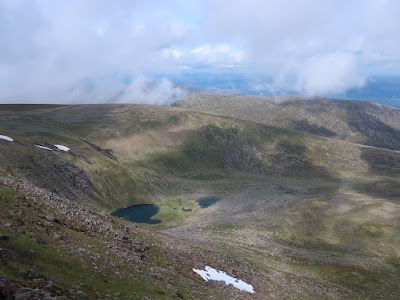Thursday 30th May 2024
When I drove up to Scotland in 2010 I took a great tour around the North Highlands echoing parts of the popular NC500 long before it was launched, but I have not been back to the historic county of Sutherland since. There were mountains in the area that I had not climbed on that occasion, partly because of poor planning and also because of bad weather, so I wanted to return and therefore my principle goal for this holiday was to return to Sutherland. To start, I left the Cairngorm Mountains and drove through the city of Inverness along the A9 up the east coast into the historic county of Sutherland and eventually stopped in the town of Golspie. I did not do any walking in this part of the county in 2010, preferring the more mountainous west coast, so this time I thought I’d start with a walk in this south eastern corner. Overlooking the town is a monument to the first Duke of Sutherland who is quite a controversial character for his part in the Highland Clearances when thousands of people were evicted from their homes to make way for sheep farming, but I just thought it would be good to walk up the hill the monument sits on. In glorious sunshine I set off up the hill, initially on a road, and as I climbed the views over Golspie and out to sea were increasingly spectacular, especially after what has seemed like months of rain this year. It was great to be finally getting great weather, but as I approached the monument I was hit by strong winds coming off the hills that made the walking considerably less enjoyable.
The views were stunning but it was only while standing on the seaward side of the monument that I was really able to appreciate them as when I moved inland along a clear path towards the top of Ben Bhraggie I was hit by strong winds. This path soon circled around the northern slopes and descended back towards the sea and I was more than happy to be out of the wind as I re-entered Ben Bhraggie Wood. The path led me past the conifers to a signpost that showed the route back to Golspie, but I had other plans. I had found a walk on the OS Maps app called ‘Country Walking: Ben Bhraggie, Highland’, which now directed me into the glen of Golspie Burn where a walk described as Golspie’s hidden gem, known as the Big Burn Walk, took me through a delightful wooded gorge. At a road I crossed the burn and took a path into the wood beside the stream where waterfalls were the star attraction, though I was also attracted to the woodland flowers that could be seen at this time of the year scattered throughout that included bluebells and later wild garlic. The well-constructed path took me safely through the gorge and eventually brought me to the foot of a tall waterfall that was not as impressive to me as the deep, cavern-like gorge surrounding the falls that had been created by the slowly eroding action of the waterfall. The fabulous path continued through the impressive gorge where woodland flowers decorated the rugged scenery, notably wild garlic, but all too soon my delight came to an end at the A9 trunk road.
On the other side of the road I followed a path through woodland abundantly decorated with flowers, though sadly now mostly gone to seed, not far from the beach as I followed the coast through to Dunrobin Castle. This is the seat of the Duke of Sutherland but I had no interest in going inside so I quickly made my way past the tourists, continuing through the woodland and soon I was out onto grassland than ran alongside the shingly beach for a relatively tedious walk beside the coast until I reached the ancient, circular, fortified dwelling called Carn Liath Broch. I have seen visited brochs and this one is less impressive than others I have seen, notably in the Outer Hebrides. As clouds began to envelop the skies I made my way back along the coast over the grassland and on re-entering the woodland around Dunrobin Castle I kept to the coast passing below the castle and formal gardens through wildflower-rich meadows. While the sun came out again, the monument on Ben Bhraggie could be seen ahead standing over Golspie and I re-entered the town at the end of a varied walk with three very different stages. From the wind-swept hilltop with extensive views to the fabulous gorge walk I finally ended with a coastal walk past Dunrobin Castle. After all the rain of this year, the sunshine on this walk was a welcome change and was the highlight of the walk.











